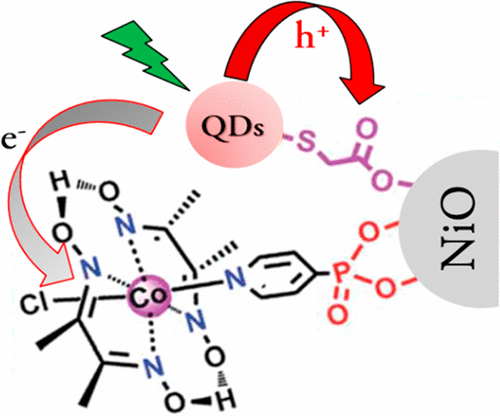当前位置:
X-MOL 学术
›
ACS Energy Lett.
›
论文详情
Our official English website, www.x-mol.net, welcomes your
feedback! (Note: you will need to create a separate account there.)
Competitive Hole Transfer from CdSe Quantum Dots to Thiol Ligands in CdSe-Cobaloxime Sensitized NiO Films Used as Photocathodes for H2 Evolution
ACS Energy Letters ( IF 19.3 ) Pub Date : 2017-10-19 00:00:00 , DOI: 10.1021/acsenergylett.7b00730 Mohamed Abdellah 1, 2 , Shihuai Zhang 3 , Mei Wang 3 , Leif Hammarström 1
ACS Energy Letters ( IF 19.3 ) Pub Date : 2017-10-19 00:00:00 , DOI: 10.1021/acsenergylett.7b00730 Mohamed Abdellah 1, 2 , Shihuai Zhang 3 , Mei Wang 3 , Leif Hammarström 1
Affiliation

|
Quantum dot (QD) sensitized NiO photocathodes rely on efficient photoinduced hole injection into the NiO valence band. A system of a mesoporous NiO film co-sensitized with CdSe QDs and a molecular proton-reduction catalyst was studied. While successful electron transfer from the excited QDs to the catalyst is observed, most of the photogenerated holes are instead quenched very rapidly (ps) by hole trapping at the surface thiols of the capping agent used as linker molecules. We confirmed our conclusion by first using a thiol free capping agent and second varying the thiol concentration on the QD’s surface. The later resulted in faster hole trapping as the thiol concentration increased. We suggest that this hole trapping by the linker limits the H2 yield for this photocathode in a device.
中文翻译:

从CdSe量子点竞争空穴迁移到巯基配体的CdSe-钴肟敏氧化镍薄膜用作光电阴极用于h 2进化
量子点(QD)敏化的NiO光电阴极依赖于有效的光致空穴注入NiO价带的过程。研究了与CdSe QDs共敏化的介孔NiO膜和分子质子还原催化剂的体系。虽然观察到成功地将电子从激发的QD转移到催化剂,但大多数光生空穴却通过捕获在用作连接剂分子的封端剂表面硫醇处的空穴而非常快速地淬灭(ps)。我们首先使用无硫醇的封端剂,然后改变QD表面的硫醇浓度来证实我们的结论。随着硫醇浓度的增加,后者导致更快的空穴捕获。我们建议连接器捕获空穴会限制器件中此光电阴极的H 2收率。
更新日期:2017-10-20
中文翻译:

从CdSe量子点竞争空穴迁移到巯基配体的CdSe-钴肟敏氧化镍薄膜用作光电阴极用于h 2进化
量子点(QD)敏化的NiO光电阴极依赖于有效的光致空穴注入NiO价带的过程。研究了与CdSe QDs共敏化的介孔NiO膜和分子质子还原催化剂的体系。虽然观察到成功地将电子从激发的QD转移到催化剂,但大多数光生空穴却通过捕获在用作连接剂分子的封端剂表面硫醇处的空穴而非常快速地淬灭(ps)。我们首先使用无硫醇的封端剂,然后改变QD表面的硫醇浓度来证实我们的结论。随着硫醇浓度的增加,后者导致更快的空穴捕获。我们建议连接器捕获空穴会限制器件中此光电阴极的H 2收率。











































 京公网安备 11010802027423号
京公网安备 11010802027423号